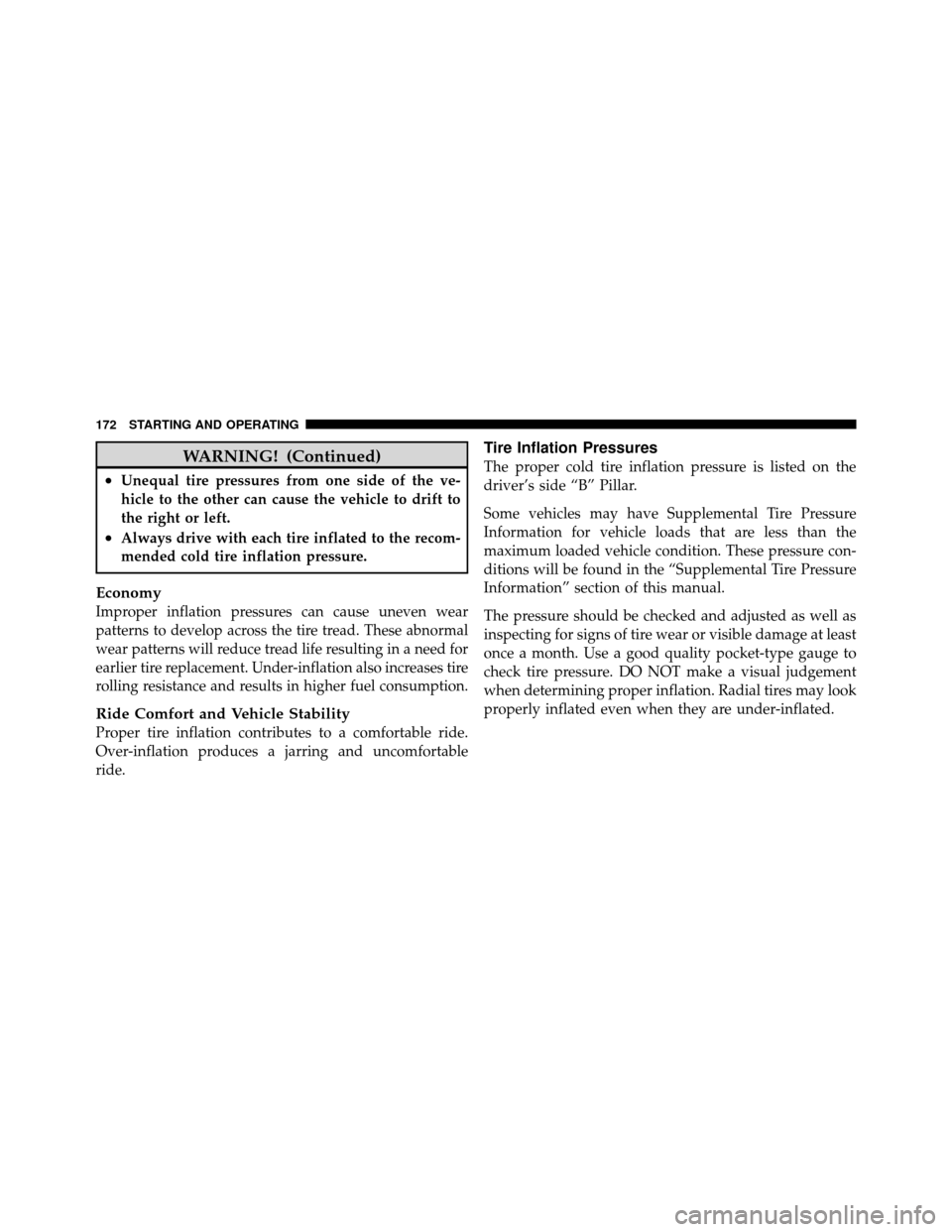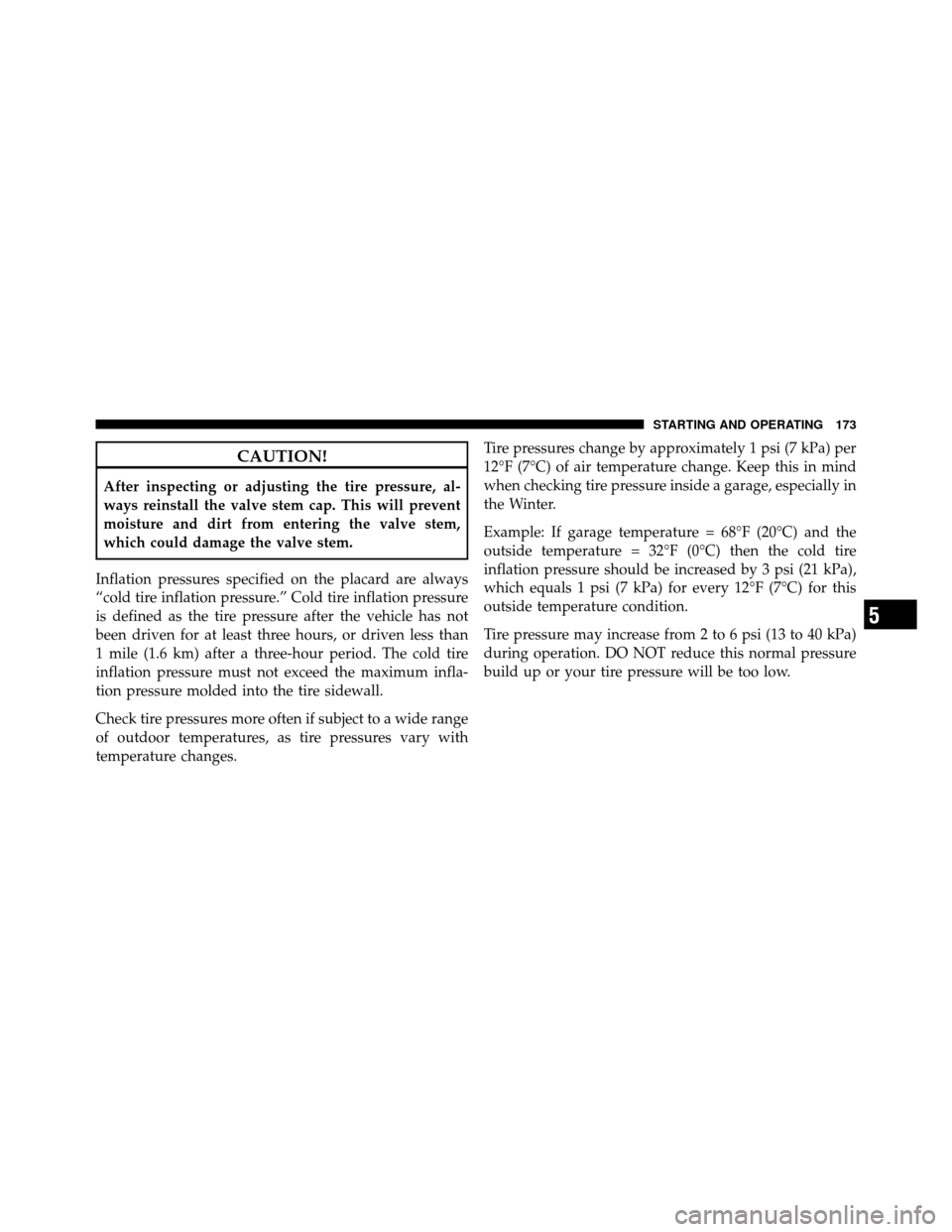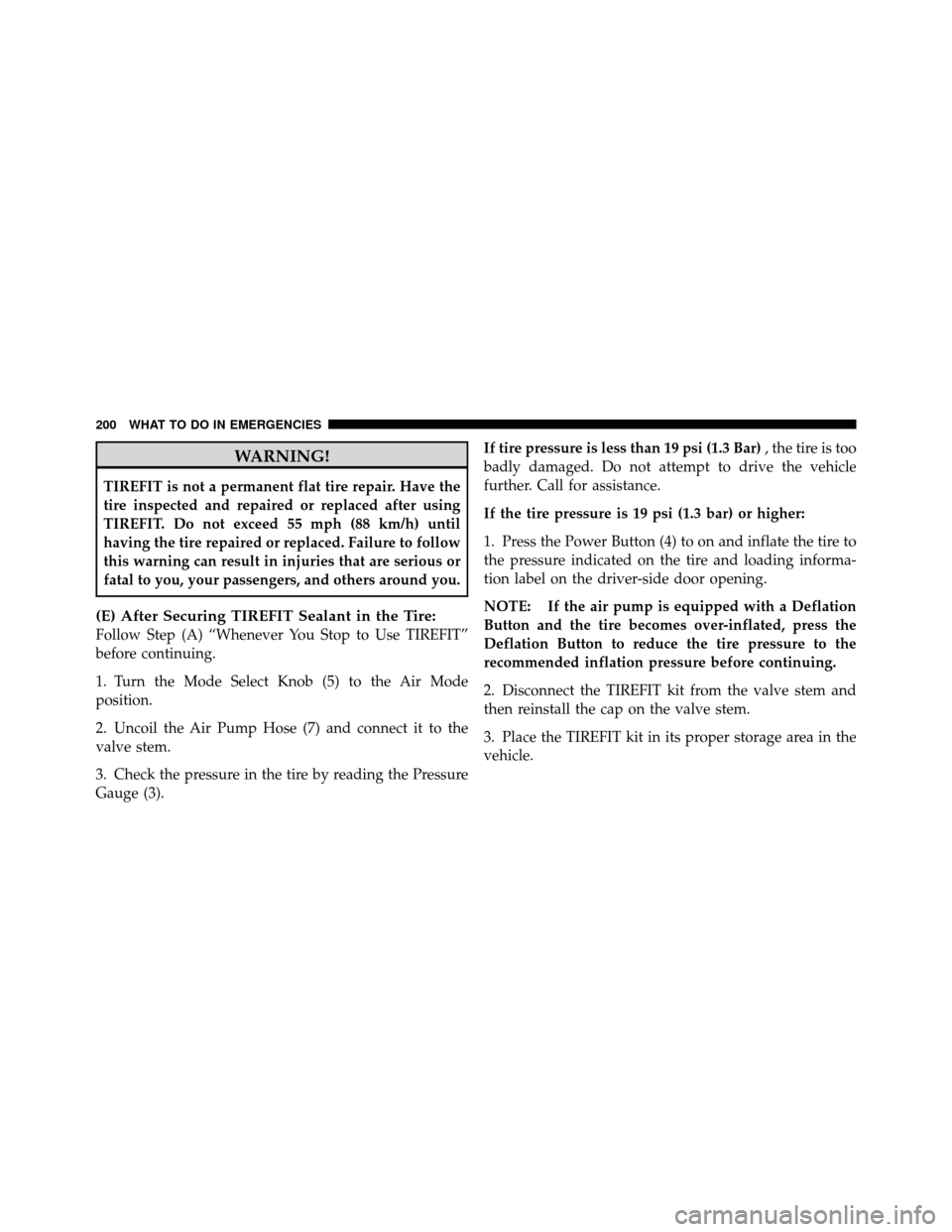2010 DODGE VIPER inflation pressure
[x] Cancel search: inflation pressurePage 176 of 315

WARNING! (Continued)
•Unequal tire pressures from one side of the ve-
hicle to the other can cause the vehicle to drift to
the right or left.
•Always drive with each tire inflated to the recom-
mended cold tire inflation pressure.
Economy
Improper inflation pressures can cause uneven wear
patterns to develop across the tire tread. These abnormal
wear patterns will reduce tread life resulting in a need for
earlier tire replacement. Under-inflation also increases tire
rolling resistance and results in higher fuel consumption.
Ride Comfort and Vehicle Stability
Proper tire inflation contributes to a comfortable ride.
Over-inflation produces a jarring and uncomfortable
ride.
Tire Inflation Pressures
The proper cold tire inflation pressure is listed on the
driver’s side “B” Pillar.
Some vehicles may have Supplemental Tire Pressure
Information for vehicle loads that are less than the
maximum loaded vehicle condition. These pressure con-
ditions will be found in the “Supplemental Tire Pressure
Information” section of this manual.
The pressure should be checked and adjusted as well as
inspecting for signs of tire wear or visible damage at least
once a month. Use a good quality pocket-type gauge to
check tire pressure. DO NOT make a visual judgement
when determining proper inflation. Radial tires may look
properly inflated even when they are under-inflated.
172 STARTING AND OPERATING
Page 177 of 315

CAUTION!
After inspecting or adjusting the tire pressure, al-
ways reinstall the valve stem cap. This will prevent
moisture and dirt from entering the valve stem,
which could damage the valve stem.
Inflation pressures specified on the placard are always
“cold tire inflation pressure.” Cold tire inflation pressure
is defined as the tire pressure after the vehicle has not
been driven for at least three hours, or driven less than
1 mile (1.6 km) after a three-hour period. The cold tire
inflation pressure must not exceed the maximum infla-
tion pressure molded into the tire sidewall.
Check tire pressures more often if subject to a wide range
of outdoor temperatures, as tire pressures vary with
temperature changes. Tire pressures change by approximately 1 psi (7 kPa) per
12°F (7°C) of air temperature change. Keep this in mind
when checking tire pressure inside a garage, especially in
the Winter.
Example: If garage temperature = 68°F (20°C) and the
outside temperature = 32°F (0°C) then the cold tire
inflation pressure should be increased by 3 psi (21 kPa),
which equals 1 psi (7 kPa) for every 12°F (7°C) for this
outside temperature condition.
Tire pressure may increase from 2 to 6 psi (13 to 40 kPa)
during operation. DO NOT reduce this normal pressure
build up or your tire pressure will be too low.
5
STARTING AND OPERATING 173
Page 178 of 315

Tire Pressures for High Speed Operation
The manufacturer advocates driving at safe speeds
within posted speed limits. Where speed limits or condi-
tions are such that the vehicle can be driven at high
speeds, maintaining correct tire inflation pressure is very
important. Increased tire pressure and reduced vehicle
loading may be required for high-speed vehicle opera-
tion. Refer to original equipment or an authorized tire
dealer for recommended safe operating speeds, loading
and cold tire inflation pressures.
WARNING!
High speed driving with your vehicle under maxi-
mum load is dangerous. The added strain on your
tires could cause them to fail. You could have a
serious accident. Do not drive a vehicle loaded to the
maximum capacity at continuous speeds above
75 mph (120 km/h).
Radial Ply Tires
WARNING!
Combining radial ply tires with other types of tires
on your vehicle will cause your vehicle to handle
poorly. The instability could cause an accident. Al-
ways use radial ply tires in sets of four. Never
combine them with other types of tires.
Cuts and punctures in radial tires are repairable only in
the tread area because of sidewall flexing. Consult your
authorized tire dealer for radial tire repairs.
Tire Spinning
When stuck in mud, sand, snow, or ice conditions, do not
spin your vehicle’s wheels faster than 30 mph (48 km/h).
Refer to “Freeing A Stuck Vehicle” in “What To Do In
Emergencies” for further information.
174 STARTING AND OPERATING
Page 180 of 315

Life of Tire
The service life of a tire is dependent upon varying
factors including, but not limited to:
•Driving style
•Tire pressure
•Distance driven
WARNING!
Tires and the spare tire should be replaced after six
years, regardless of the remaining tread. Failure to
follow this warning can result in sudden tire failure.
You could lose control and have an accident resulting
in serious injury or death.
Keep dismounted tires in a cool, dry place with as little
exposure to light as possible. Protect tires from contact
with oil, grease, and gasoline.
Replacement Tires
The tires on your new vehicle provide a balance of many
characteristics. They should be inspected regularly for
wear and correct cold tire inflation pressure. The manu-
facturer strongly recommends that you use tires equiva-
lent to the originals in size, quality and performance
when replacement is needed. (Refer to the paragraph on
“Tread Wear Indicators”). Refer to the “Tire and Loading
Information” placard for the size designation of your tire.
The service description and load identification will be
found on the original equipment tire. Failure to use
equivalent replacement tires may adversely affect the
safety, handling, and ride of your vehicle. We recommend
that you contact your original equipment or an autho-
rized tire dealer with any questions you may have on tire
specifications or capability.
176 STARTING AND OPERATING
Page 202 of 315

2. Connect the Power Plug (8) to a different 12 Volt
power outlet in your vehicle or another vehicle, if avail-
able. Make sure the engine is running before turning ON
the TIREFIT kit.
3. The Sealant Bottle (1) may be empty due to previous
use. Call for assistance.
NOTE:If the Mode Select Knob (5) is on air mode and
pump is operating, air will dispense from the Air Pump
Hose (7) only, not the Sealant Hose (6).
If the sealant (white fluid) does flow through the
Sealant Hose (6):
1. Continue to operate pump until sealant is no longer
flowing through hose (typically takes 30 - 70 seconds). As
the sealant flows through the Sealant Hose (6), the
Pressure Gauge (3) can read as high as 70 psi (5 Bar). The Pressure Gauge (3) will decrease quickly from approxi-
mately 70 psi (5 Bar) to the actual tire pressure when the
Sealant Bottle (1) is empty.
2. The pump will start to inject air into the tire immedi-
ately after the Sealant Bottle (1) is empty. Continue to
operate pump and inflate the tire to the pressure indi-
cated on the tire pressure label on the driver-side latch
pillar (recommended pressure). Check the tire pressure
by looking at the Pressure Gauge (3).
If the tire does not inflate to at least 26 psi (1.8 Bar)
pressure within 15 minutes:
•The tire is too badly damaged. Do not attempt to drive
the vehicle further. Call for assistance.
NOTE: If the air pump is equipped with a Deflation
Button and the tire becomes over-inflated, press the
Deflation Button to reduce the tire pressure to the
recommended inflation pressure before continuing.
198 WHAT TO DO IN EMERGENCIES
Page 204 of 315

WARNING!
TIREFIT is not a permanent flat tire repair. Have the
tire inspected and repaired or replaced after using
TIREFIT. Do not exceed 55 mph (88 km/h) until
having the tire repaired or replaced. Failure to follow
this warning can result in injuries that are serious or
fatal to you, your passengers, and others around you.
(E) After Securing TIREFIT Sealant in the Tire:
Follow Step (A) “Whenever You Stop to Use TIREFIT”
before continuing.
1. Turn the Mode Select Knob (5) to the Air Mode
position.
2. Uncoil the Air Pump Hose (7) and connect it to the
valve stem.
3. Check the pressure in the tire by reading the Pressure
Gauge (3).If tire pressure is less than 19 psi (1.3 Bar)
, the tire is too
badly damaged. Do not attempt to drive the vehicle
further. Call for assistance.
If the tire pressure is 19 psi (1.3 bar) or higher:
1. Press the Power Button (4) to on and inflate the tire to
the pressure indicated on the tire and loading informa-
tion label on the driver-side door opening.
NOTE: If the air pump is equipped with a Deflation
Button and the tire becomes over-inflated, press the
Deflation Button to reduce the tire pressure to the
recommended inflation pressure before continuing.
2. Disconnect the TIREFIT kit from the valve stem and
then reinstall the cap on the valve stem.
3. Place the TIREFIT kit in its proper storage area in the
vehicle.
200 WHAT TO DO IN EMERGENCIES
Page 306 of 315

Time Delay........................... 89
Heater ............................... 134
High Beam Indicator ..................... 109
High Beam/Low Beam Select (Dimmer) Switch . . . 91
Hood Release ........................... 86
Hydraulic Clutch Fluid .................... 236
Ignition ............................... 12
Key ................................ 12
Ignition Key Removal ..................... 12
Illuminated Entry ........................ 17
Infant Restraint ........................ 56,57
Inflation Pressure Tires .................... 113
Inside Rearview Mirror .................... 82
Instrument Panel and Controls .............. 107
Instrument Panel Lens Cleaning ............. 240
Interior Appearance Care .................. 239
Interior Lighting ....................... 88,91
Interior Lights ......................... 91,93Intermittent Wipers (Delay Wipers)
............ 95
Introduction ............................. 4
Jump Starting .......................... 202
Key-In Reminder ......................... 13
Keyless Entry System ...................... 18
Keys ................................. 12
Knee Bolster ............................ 42
Lane Change and Turn Signals ............... 91
Lap/Shoulder Belts ....................... 34
Latch Plate ............................. 35
Latches ................................ 67
Hood ............................... 86
Lead Free Gasoline ...................... 181
Leaks, Fluid ............................ 67
Life of Tires ............................ 176
Liftgate ................................ 29
302 INDEX
Page 312 of 315

Shoulder Belts........................... 34
Signals, Turn ....................... 67,91,111
Slippery Surfaces, Driving On ............... 151
Snow Tires ............................ 178
Speedometer ........................... 108
Starting ............................... 144
Emergency (Jump Starting) ............... 202
Engine Fails to Start .................... 146
Starting and Operating .................... 144
Starting Procedures ...................... 144
Steering Power .............................. 154
Tilt Column ........................... 96
Storage ............................... 247
Storage, Vehicle ......................... 138
Stuck, Freeing .......................... 205
Supplemental Restraint System - Airbag ........ 42
Synthetic Engine Oil ...................... 215 Tachometer
............................ 116
Temperature Gauge, Engine Coolant .......... 116
Theft Alarm (Security Alarm) ................ 13
Theft System (Security Alarm) ............... 13
Tilt Steering Column ...................... 96
Tire and Loading Information Placard ......... 167
Tire Identification Number (TIN) ............. 165
Tire Markings .......................... 161
Tire Safety Information .................... 161
TIREFIT .............................. 191
Tires ............................ 67,171,293
Aging (Life of Tires) .................... 176
Air Pressure .......................... 171
General Information .................... 171
High Speed .......................... 174
Inflation Pressures ..................... 172
Life of Tires .......................... 176
Load Capacity ..................... 167,168
Pressure Monitor System (TPMS) ........... 179
308 INDEX